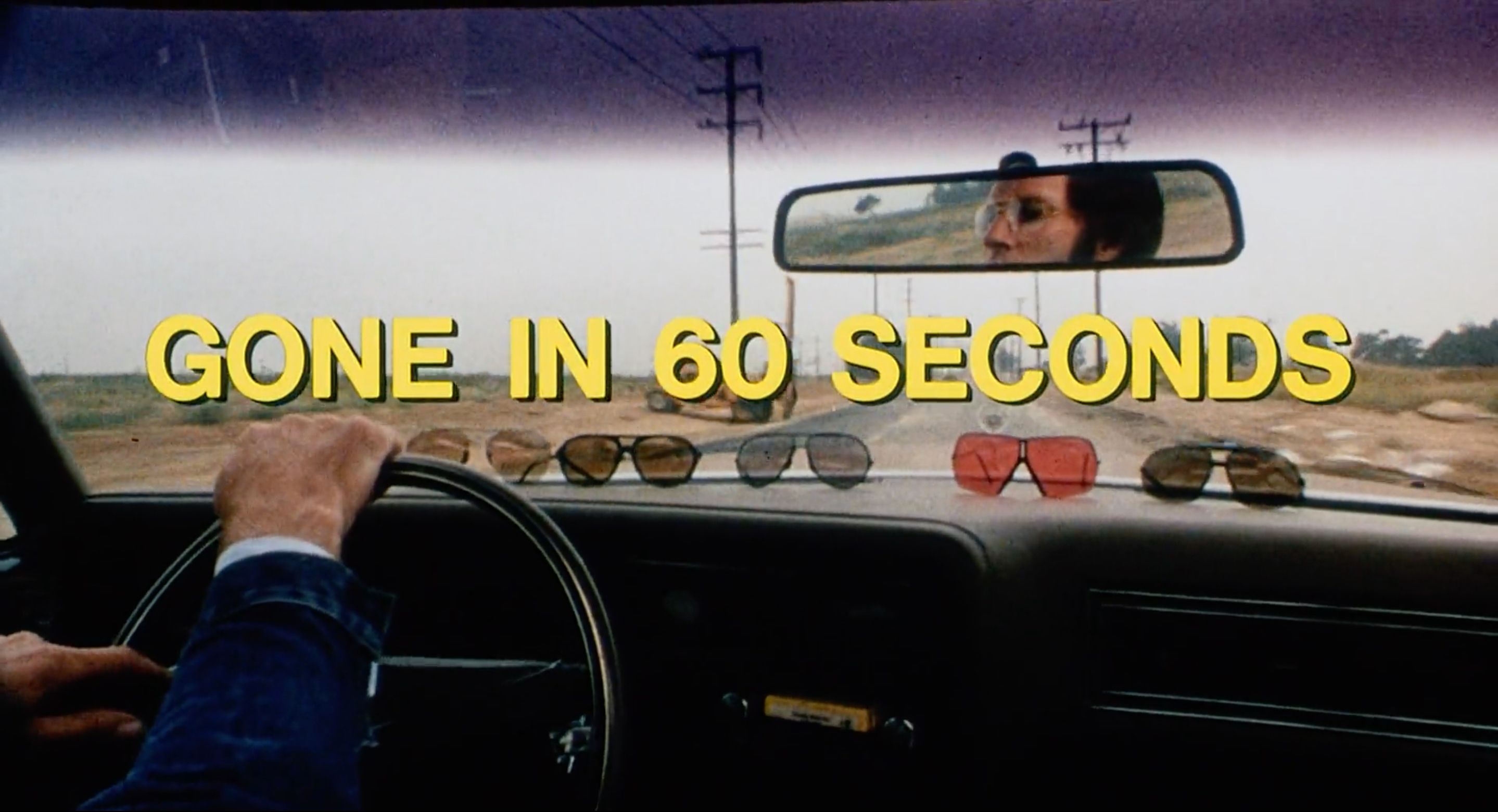 Inevitably, there are spoilers here, but I’ve tried to keep them to a minimum in the review half, enough that you could read it and still enjoy and be surprised by the film. However, by necessity, the game half spoils the film much more thoroughly. Read with care. Thanks!
Inevitably, there are spoilers here, but I’ve tried to keep them to a minimum in the review half, enough that you could read it and still enjoy and be surprised by the film. However, by necessity, the game half spoils the film much more thoroughly. Read with care. Thanks!
What is it? Gone in 60 Seconds, written and directed by H.B. Halicki, and starring H.B. Halicki, Marion Busa, George Cole, Butch Stockton and Phil Woods. Oh, and “Eleanor.”
First viewing? Yes.
What’s it about? An insurance investigator (Halicki) uses his business as a front for a gang of car thieves and their chop shop. When he gets an order for 48 cars from a drug lord, he is only given five days to steal and deliver them.
What are your thoughts about it? Years ago, I turned off the celebrated documentary Los Angeles Plays Itself after about twenty minutes, despite all the praise I’d read from critics and heard from friends.
There was something about it that put me off. Director Thom Andersen narrates the film, which is about how the city has been used and visually represented throughout film history. Andersen’s tone is — look, I could very well be misinterpreting or projecting — but his tone, to my ears, was snide and condescending. “Listen up, dummies,” his tone seemed to say, “I watch movies that take place in Los Angeles on a deeper level than you. Also, it’s offensive for movie villains to live in houses designed by famous architects.”
But there was one moment that puzzled me. I don’t have access to the movie, so I can’t fact check any of this, but my memory is that Andersen introduced, in admiring tones, Gone in 60 Seconds and its legendary 40 minute car chase. Andersen explained how the chase is composed of shots that are physically contiguous; that is, when the bright yellow car driven by the protagonist turns down a street, the next shot has the car actually on that street. This is, of course, not how movies are usually put together. It’s more common for different shots to be filmed in different locations, sometimes miles or even entire states away, and assembled in the editing room. Andersen’s admiration had me befuddled; it wasn’t clear to me why this was important or notable other than being unusual. It respected Los Angeles geography. So what? But I hadn’t seen Gone in 60 Seconds, so I thought perhaps I was being unfair. Maybe there was more to it in context. Then I stopped thinking about it.
Last week, I watched Gone in 60 Seconds. I don’t think I was being unfair.
 This credit is not the first time the movie will seem like a heavily-edited porno.
This credit is not the first time the movie will seem like a heavily-edited porno.
First, a little about the movie, up until the big chase. The first ten minutes or so start off well enough. Insurance investigator Pace (director H.B. Halicki, who also did all his own vehicular stunts) arrives at the site of a train crash, and finds a destroyed car. We then watch as Pace uses his access to take the plates and other identifying markers from the wreck, and put them on a stolen car of the exact make and model, making it “legitimate.” There’s a level of detail to this sequence that comes from good research, good access, or both, and for a moment, the movie seems downright educational.
But this soon falls apart. In this initial scene, the process of turning a stolen car into a legit one is conveyed through images and voice-over that, at first, clash intriguingly. The images don’t immediately reflect what’s being said, forcing the viewer to pay attention and try to follow two different information streams at once. It’s bracing (for a moment, at least) and gives the impression of a deeper intelligence at work.
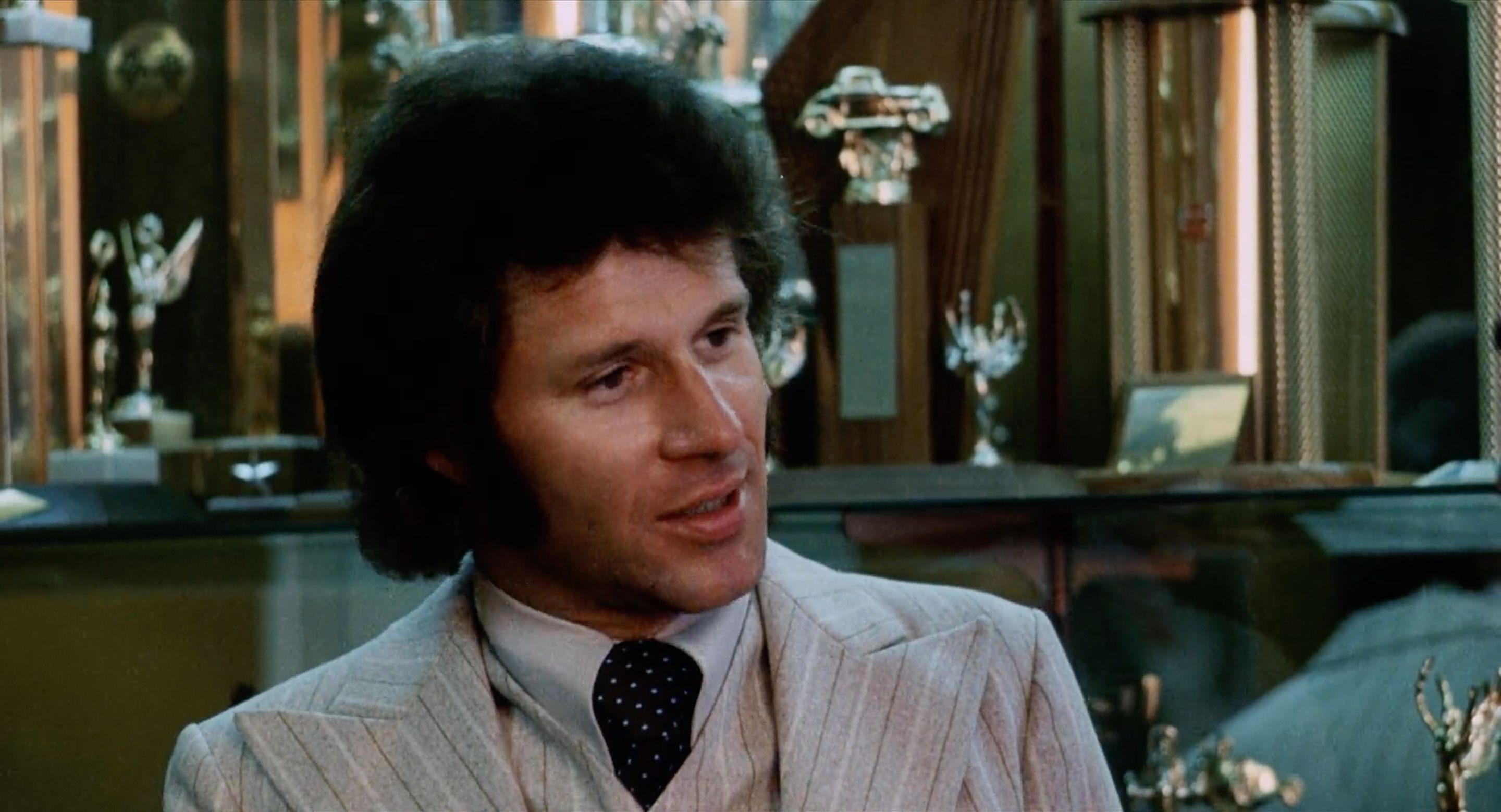 Pace (H.B. Halicki) in insurance investigator mode.
Pace (H.B. Halicki) in insurance investigator mode.
It soon becomes apparent, however, that this isn’t some stylistic strategem, but simple amateurishness. Scenes continue in this fashion, as if the filmmakers didn’t get all the shots they needed, and opted to paper over the gaps with voice-over. It culminates with a sequence where the film is still delivering exposition, but this time over shots of a wedding. The scene is intended to indicate and clarify the relationships between the main characters. It completely fails on that front.
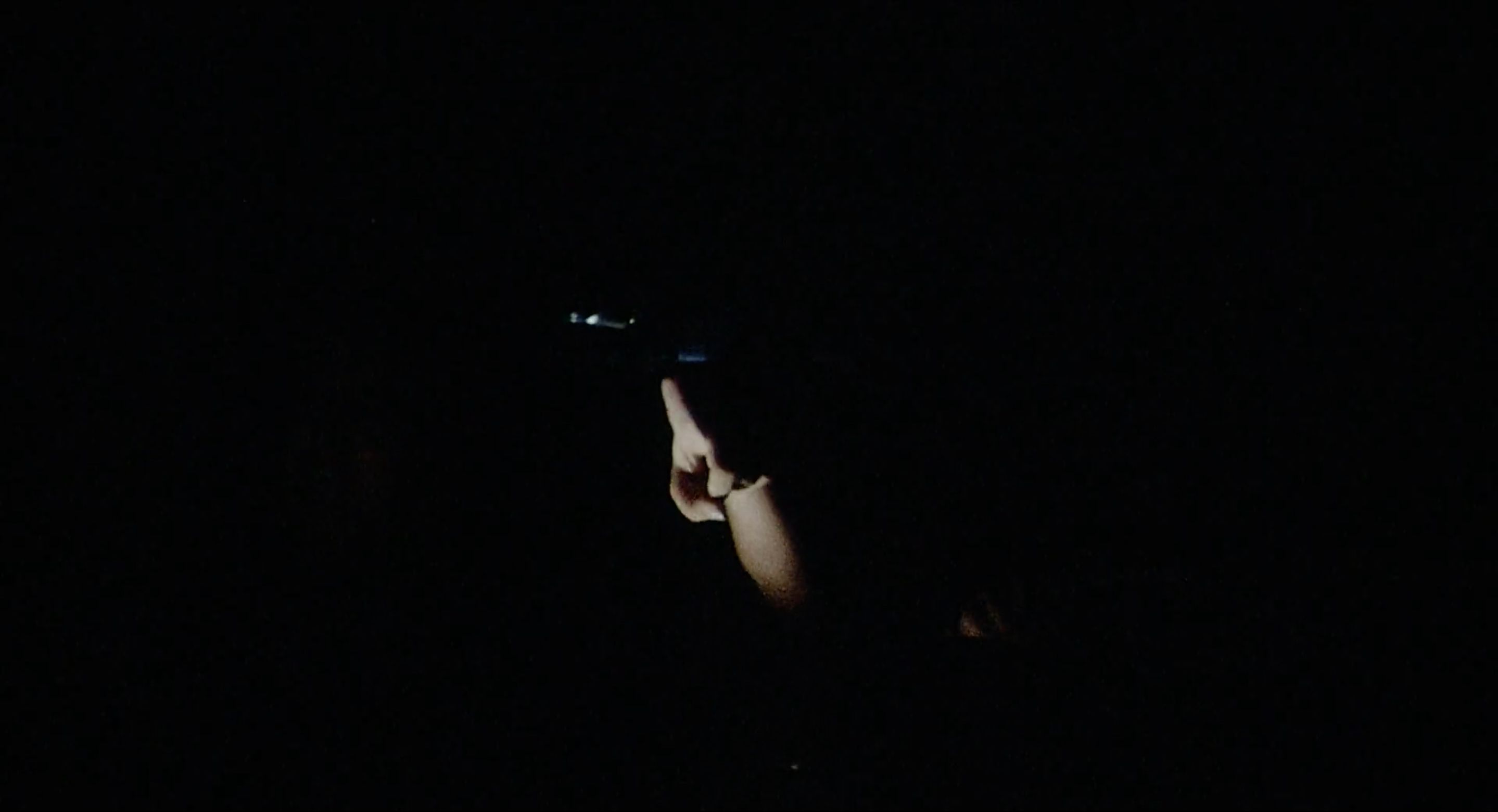 Didn’t have time to go into it fully, but there’s a shorter chase, before the big one, that takes place at night and is only lit by ambient street light. This is the shot right before a car driven by two women (?) crashes and flips for some reason.
Didn’t have time to go into it fully, but there’s a shorter chase, before the big one, that takes place at night and is only lit by ambient street light. This is the shot right before a car driven by two women (?) crashes and flips for some reason.
Eventually, the images and the sound find each other again, but by this time, it doesn’t matter. Amateurishness reveals itself again with how the plot is constructed. The idea is that Pace and his crew need to steal 48 cars in five days. Can you see what’s wrong with this set-up already? There is no way to properly dramatize this problem. Is there — can there? — be any suspense about whether they’ll be able to steal 47 of those cars? Are they going to get tripped up after the 28th one? The 16th? The 5th? Of course not. The only one that’s going to cause them trouble is the last one. The first 1472 don’t matter3. It’s a cheap way to make the thieves look badass without putting in the effort4. The stealing of the first forty-seven is reduced to a montage, because it has to be. Halicki recognizes this as an opportunity for comedy, and he, well, he attempts to capitalize on it. But it also requires interesting variations on a theme, and Halicki comes up short. Every time, they roll up, distract the owner or otherwise wait until they’re out of sight, then then get in and steal it. It has the perverse effect of making these risky actions look mundane and unexciting.
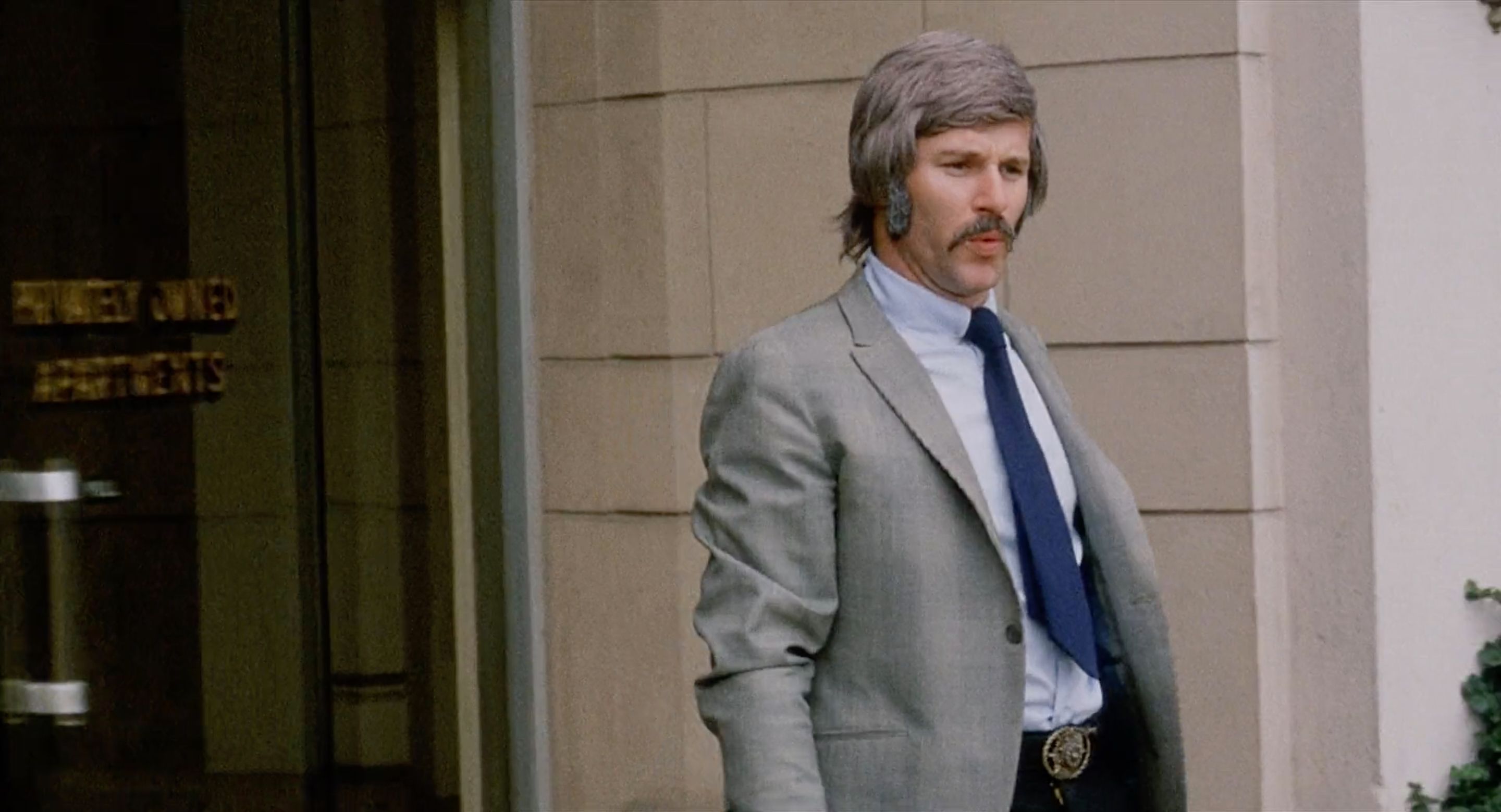 Pace (director H.B. Halicki) in car-stealing disguise mode. I’ma set it straight, this Watergate.
Pace (director H.B. Halicki) in car-stealing disguise mode. I’ma set it straight, this Watergate.
Finally, about halfway through, they get all the cars, but for reasons I confess I didn’t understand, they return one of the stolen cars to its owner. Pace then steals another of the same make and model. One of Pace’s cohorts (his brother-in-law, I think?) squeals on him to the cops, and that’s when the big ol’ chase begins. Let’s take it on its own terms as a piece of cinema.
It’s long.
That’s it. It’s long. You’d think, for a sequence that’s half the movie, there’d be some rising tension, some underlying structure that was building towards something, or just any reason why the chase needed to be this lengthy. There is none. Pace drives away from the cops, they pursue, a few times it looks like Pace is gonna get caught, but then he escapes. There is a climactic moment where Pace escapes for good, but it could arrive at any point during the chase. And for all of Andersen’s enthusiasm over the contiguous shots, it’s still occasionally difficult to parse. There’s one scene where Pace is trapped (or at least we’re told he’s trapped) on a small dusty hill outside a construction zone, surrounded by cops. We’re meant to think there’s nowhere for him to go. Then, out of nowhere and for no reason, a cop car pulls a Leeroy Jenkins and goes up the hill after Pace. This — I guess??? — gives Pace an opening and he escapes. But again, if not for the dialogue, this wouldn’t be clear from the shots alone.
If that’s all there was, if that’s all I knew about this movie, I’d probably shrug, give it 1 1/2 stars, and move on. (Bad chases, like bad pizza and bad rpg sessions, are still okay.5) But I made the mistake of reading up on it on Wikipedia, and discovered something that made me completely reconsider everything about the movie:
There was no script.
This suggests a number of things. It suggests why the first part of the movie has so much voice-over. It suggests why the dirt hill escape scene makes no sense. It suggests why the stolen car montage is so monotonous. It suggests that the chase takes up so much running time because they didn’t know what else to do with the story, and it was the only thing in the filmmakers’ skill set. (It certainly wasn’t dialogue, acting, or story construction.) It suggests that the chase was done in physically contiguous shots, not out of respect for the geography of Los Angeles, but because, without a script, they needed it to cut together well. But it also suggests that it simply never occurred to them to do it any other way.
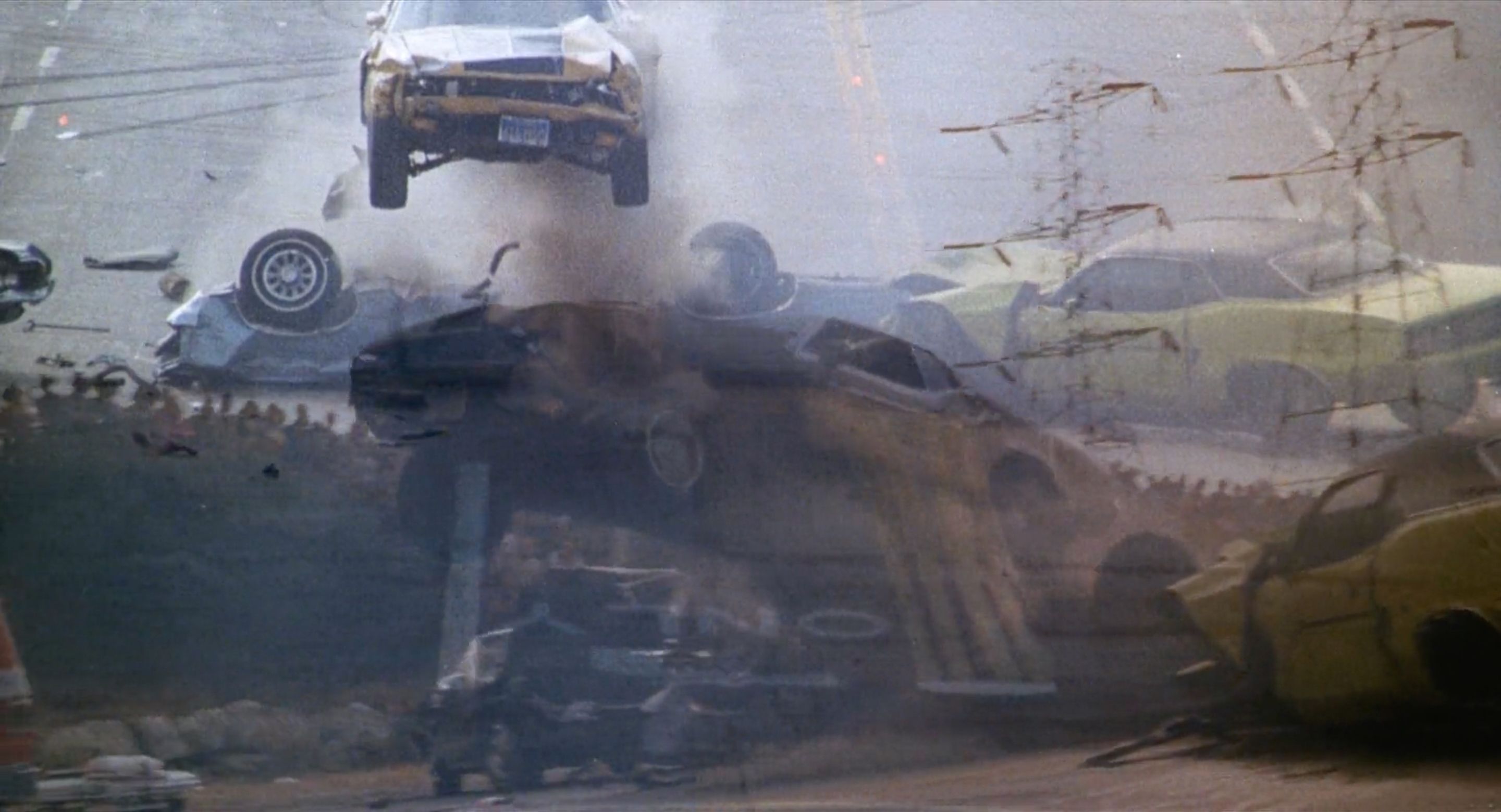 We are proud to announce this 128-foot stunt jump’s graduation from 128-Foot Stunt Jump High School.
We are proud to announce this 128-foot stunt jump’s graduation from 128-Foot Stunt Jump High School.
How many stars out of five? One-half. I’m using the Letterboxd system, which doesn’t use zero stars, so know that this is the lowest rating I can give.
Where can I stream it? As of this writing6, you can watch it for free on Tubi, Pluto TV, Hoopla, and Vudu-Fandango, or rent or buy it from Amazon Video or Vudu-Fandango.
What can we take from it? H.B. Halicki was a mechanic, owner of an impound business and junk yard, and automobile collector, with no apparent training in filmmaking or stunt driving. During the filming of the chase, Halicki’s car was clipped by a Cadillac, causing it to spin out into a light pole. When Halicki regained consciousness, he reportedly asked if they got the shot. (They did, and it’s in the finished film.) Halicki also performed the final stunt in the film, where he launches Eleanor 128 feet through the air. The impact compacted ten of his vertebrae, and he walked with a limp for the rest of his life. In 1989, at the age of 48, while prepping a stunt for Gone in 60 Seconds 2, a cable attached to a water tower snapped, shearing a telephone pole, which landed on Halicki, killing him instantly.
 RECKLESS (DESCRIPTOR)
RECKLESS (DESCRIPTOR)
You make ordinary risk-takers look like conservative worry-warts. There is little you won’t try, and the fact that you don’t have a plan is a feature, not a bug. You gain the following characteristics:
Pure Adrenaline: +6 to your Speed Pool.
Skill: Any task that is dangerous (GM’s approval) is eased.
Temerarious: You must roll for every task you attempt that begins with an unadjusted level of 1 or higher, even if you have lowered the level of the challenge to zero through skills, etc. If you roll a natural 1 (which will be a success for a level 0 task), you immediately take damage equal to the unadjusted level of the task you were attempting.
Endangerment: You must roll for every task you attempt that begins with an unadjusted level of 1 or higher, even if you have lowered the level of the challenge to zero through skills, etc. If you roll a natural 20, one of your companions immediately takes damage equal to the unadjusted level of the task you were attempting.
Initial Link to the Starting Adventure: From the following list of options, choose how you became involved in the first adventure.
Someone needed a getaway driver, and that’s what you do.
You joined the group on a dare.
You were on the run from a previous exploit that went bad, and you joined the other characters as a way to hide.
You somehow, through your actions, caused the predicament that you and the other characters are now in.
NEXT TIME, ON AGAINST THE ’70S: Damnation Alley (1977, Jack Smight) Originally published 2/13/22 on Substack.
This reminds me of the movie 30 Days of Night, where vampires take over an Alaskan town that is in darkness for a month. Unlike a lot of people I know, I like the movie, but the thirty day concept can’t be dramatized. At a point in the middle, there’s a caption that says something like “17 days later” but there’s no sense of what these humans have done to survive and hide from vampires all that time. And I don’t even really blame the filmmakers — I don’t think it can be done in a two hour movie. Turn the movie into 3 Days of Night and most of its structural problems fall away. (What if it was an N-hour miniseries, you ask? That could possibly work, but remember, you’d still have to fill in all those missing days with how these people survive, without being repetitive. What bugs me about 30 Days of Night, both the comic and the movie, is that it paints itself into a corner where it has to cheat, but a little forethought could’ve prevented that.)↩︎
This reminds me of that logic puzzle about Monty Hall and the three doors. Not gonna recapitulate it, so go here if you’ve never encountered it. Specifically, it reminds me of one person’s explanation of the counterintuitive answer: imagine if it wasn’t three doors, but ten thousand. So you’d pick a door and then all the other doors, all 99,998 of them, would fling open. Except for a single lone door, in the middle of thousands of other doors. Do you still go with the one you picked?↩︎
This reminds me of a scene from The Simpsons, where Moe is in a bartending contest hosted by Duff Man. It’s three rounds long, and after the first two (which, IIRC, Moe fails), Duff Man says, “Now, our final round, which counts for 98% of the total score, making the previous rounds a complete waste.”↩︎
This reminds me of Smokey and the Bandit (1977, Hal Needham), which I plan to cover here in the future. So, probable spoiler: Bo and Cledus experience no real difficulties in their journey from Milan to Minsk, I mean, Texarkana to Atlanta. They look like difficulties, they seem like difficulties, but everything they do is effortless in order to make them look good. It hurts the film considerably.↩︎
ETA 8/18/24: Now that I’ve read up on what a bad rpg session can really look like, and understand that I’ve never really had one, I have to renounce that statement. I can still choke down bad pizza when need be, tho.↩︎
2/13/22↩︎